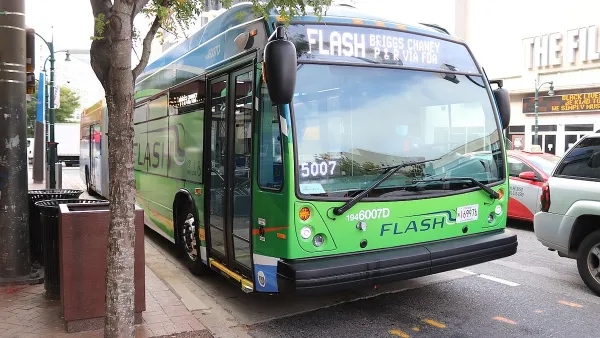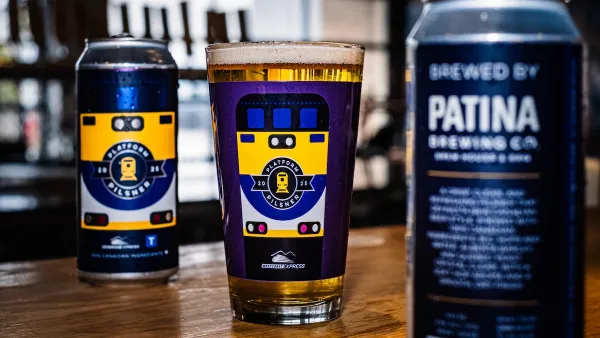A couple of years ago, I was listening to a friend explain why she left Rochester for Jacksonville. "I was tired of digging my car out of the snow." It occurred to me that the nexus between driving and winter weather may at least partially explain the decline of America’s northern Rust Belt. Here’s why: car care and storage makes snow a bigger bother than might otherwise be the case: if you don’t have a heated garage, you have to dig your car out of the snow every day, and if you park on the street you may have to constantly move your car to accommodate municipal snow removal.
A couple of years ago, I was listening to a friend explain why she left Rochester for Jacksonville. "I was tired of digging my car out of the snow." It occurred to me that the nexus between driving and winter weather may at least partially explain the decline of America's northern Rust Belt.
Here's why: car care and storage makes snow a bigger bother than might otherwise be the case: if you don't have a heated garage, you have to dig your car out of the snow every day, and if you park on the street you may have to constantly move your car to accommodate municipal snow removal.
By contrast, if you live in either a snow-free southern city or a transit-friendly northern city, you don't have this problem: in the first case because there is no snow to worry about, in the second case because there is no car to worry about (or at least you don't have to use it as often if you own one). So to the extent snow governs your relocation decisions, places that are both (1) car-dependent and (2) snowy are at a disadvantage compared to places that share only one of these characteristics.
And indeed, such places have been especially noncompetitive in recent decades. As a general matter, southern cities have grown faster than northern cities. But within the north, not all regions are equal. Some "Rust Belt" northern regions, such as Cleveland and Buffalo, have suffered massive outmigration; their central city populations have nosedived, while their regional populations have stagnated. By contrast, other northern cities have survived the late 20th century more comfortably. Their central cities have either grown or lost population at a slower rate than in the Rust Belt. And by and large, the least car-dominated American cities are within this group.
Among the twenty-five largest American cities, five have significant snow levels (over about 20 inches per year) and significant (over 25 percent of central-city residents) transit ridership: Washington, Boston, Philadelphia, Chicago, and New York. * Three of these cities (Washington, Boston and Chicago) gained population between 1990 and 2007. Two lost population - but at a pretty mild rate: Philadelphia lost 8 percent of its population, and Washington lost about 3 percent. All five cities were part of growing metropolitan areas.**
By contrast, the most rapidly declining cities tend to be more automobile-dependent. Four metropolitan areas with over one million people lost population between 1990 and 2007: all of them had lower transit ridership than the cities discussed above, and three of them (Pittsburgh, Buffalo and Cleveland) had very high snowfall levels. All three lost well over 10 percent of their central-city population since 1990. (The fourth, New Orleans, lost population in part due to a natural disaster). Some other car-oriented snowy cities, such as Detroit and St. Louis, have suffered from massive central-city decline and slow metropolitan growth.
On the other hand, some cities combined fairly high levels of snow with population growth. For example, Minneapolis and Denver have more snowfall than most of our most heavily transit-oriented cities, yet both their central cities and surrounding suburbs have gained population in recent decades. And Indianapolis and Columbus have very low transit ridership (under 5 percent of city residents) and yet have gained population (although their snowfall is at the low end of the "Snow Belt", with only 20-30 inches per year, comparable to Washington and New York but lower than Boston or Chicago).*** So I don't think one can plausibly argue that the combination of so-so public transit and high snowfall automatically leads to decline.
But as a matter of common sense, it does seem logical to me that a car-oriented Snow Belt city will, all else being equal, be a marginally less attractive place to live than (a) a less car-oriented city with better alternatives to driving, and (b) a car-oriented city where residents do not have to struggle with snow. Given this conclusion, it makes more sense**** for a snowy city to invest in public transit (and to steer development to places already served by transit) than for a not-so-snowy one to do so.
*Transit ridership statistics from the 2000 Census are at http://www.census.gov/prod/2004pubs/03statab/trans.pdf (Table 1092). The preceding table lists ridership by metropolitan area; because suburbs are more car-dependent than cities, regional ridership tends to be much lower than central-city ridership. However, all of these cities have regional ridership higher than the average.
** http://www.census.gov/prod/2008pubs/09statab/pop.pdf (Tables 19, 26) (city and metro area population statistics).
*** http://lwf.ncdc.noaa.gov/oa/climate/online/ccd/snowfall.html (snowfall statistics by city)
****Or, if you favor expanded public transit in all cities, "even more sense."

Planetizen Federal Action Tracker
A weekly monitor of how Trump’s orders and actions are impacting planners and planning in America.

Maui's Vacation Rental Debate Turns Ugly
Verbal attacks, misinformation campaigns and fistfights plague a high-stakes debate to convert thousands of vacation rentals into long-term housing.

San Francisco Suspends Traffic Calming Amidst Record Deaths
Citing “a challenging fiscal landscape,” the city will cease the program on the heels of 42 traffic deaths, including 24 pedestrians.

Defunct Pittsburgh Power Plant to Become Residential Tower
A decommissioned steam heat plant will be redeveloped into almost 100 affordable housing units.

Trump Prompts Restructuring of Transportation Research Board in “Unprecedented Overreach”
The TRB has eliminated more than half of its committees including those focused on climate, equity, and cities.

Amtrak Rolls Out New Orleans to Alabama “Mardi Gras” Train
The new service will operate morning and evening departures between Mobile and New Orleans.
Urban Design for Planners 1: Software Tools
This six-course series explores essential urban design concepts using open source software and equips planners with the tools they need to participate fully in the urban design process.
Planning for Universal Design
Learn the tools for implementing Universal Design in planning regulations.
Heyer Gruel & Associates PA
JM Goldson LLC
Custer County Colorado
City of Camden Redevelopment Agency
City of Astoria
Transportation Research & Education Center (TREC) at Portland State University
Jefferson Parish Government
Camden Redevelopment Agency
City of Claremont






























